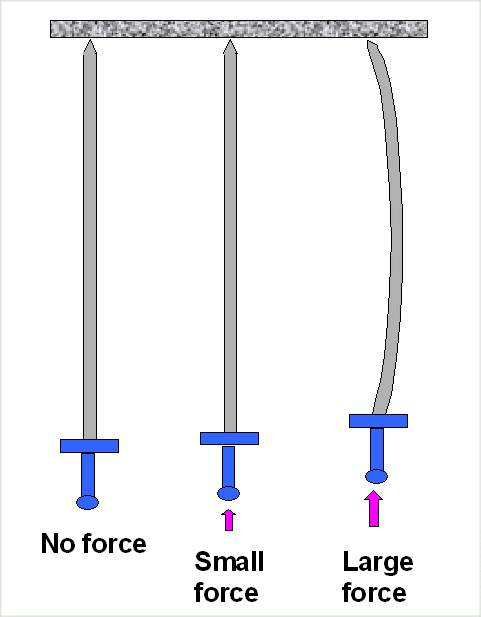12.2.3 Sword Buckling
 |
|
| Basic "buckling beam" experiment |
- For forces (better would be stress=force per area, remember?) below a certain limit, the beam (or sword) deforms elastically by getting somewhat shorter as shown (exaggeratedly) in the middle situation above.
- For forces at or above a certain critical limit the beam (or sword) deforms elastically by buckling sideways as shown (in the right-hand situation above).
- Increasing the force beyond that critical limit makes the buckling more pronounced, followed by permanent bending (plastic deformation) and eventually fracture.
- Buckling occurs for all structures under compressive stress - like columns, towers or simply most of architecture. If your column or wall starts to buckle because it was designed too flimsy or the load gets too large because other columns holding up the structure were destroyed, it is all over! The World Trade Centers in 2001 bear witness to this.
- Guess: Thick columns are more stable than thin ones. So double the cross-sectional area and you double the critical
force?
Reality: No. The critical force is not proportional to the cross-sectional area but to lA, the area moment of inertia. If you increase the area by a factor of two, the area moment of inertia increases much more than that. For a beam with square cross-section, for example, lA increases with the square of the area! - Guess: Stiffer materials are less sensitive to buckling. So the critical force is proportional to Young's modulus
Y?
Reality: That is correct. - Guess: A long blade will buckle more easily than a short one. The buckling force thus might be inversely proportional
to the length?
Reality: Not really. The critical force decreases with the square of the length!
When you then kill your wife since your sword ran right through her instead of buckling, you might be somewhat surprised if not sorry. Well - I meant mechanically unwielding, of course! Why didn't your sword buckle?
Simple. Wives are typically not hard and unyielding objects (mechanically speaking). If the force it takes to penetrate a target is smaller than the critical force, you just cannot built up the critical force in the tip region. Even if your sword hits now a wall on the other aside of your (former) wife, it will not buckle anymore. Why? Because the wife impaled upon the blade is now part of the blade (again mechanically speaking) The cross-sections increases by quite a bit and the critical force is now much larger.